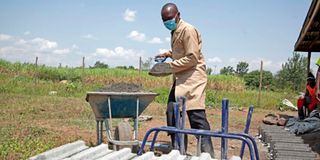Ibrahim Odie learns how to make building blocks on YouTube

Ibrahim Odie makes interlocking blocks at his workstation in Awasi, Kisumu County on July 10, 2021.
With skills he acquired on YouTube, Mr Ibrahim Odie has capitalised on the production of interlocking bricks.
It all started from a mere Google search on the most suitable and cost-effective housing construction solution for his family.
After browsing through the internet, the use of interlocking blocks popped up as the ideal way to build a permanent house compared to the masonry stone and burnt bricks.
“I realised that the technology would bring down my construction cost by between 30 to 40 per cent,” said Mr Odie.
Other than the high cost of labour, he established that sand, cement and stones are the major cost drivers in construction.
He later linked up with a Nairobi-based random trainer on Facebook. The trainer shared with him several videos of how to make the interlocking blocks.
Manual machine
After buying the interlocking block machines from the trainer, Mr Odie was offered a one-week free practical demonstration on how to make the building material.
“I used my savings of Sh18,000 to buy a manual machine,” he told Nation.Africa.
Lucky for Mr Odie, his neighbour in Awasi, Kisumu County, soon ordered 3,000 bricks to complete his three-bedroom house.
He then bought quarry dust and cement, the ingredients for making the blocks.
The machine, shaped in size 6 by 9 inch, compresses a mixture of quarry dust, water and cement to produce solid blocks.
“To avoid cracking, the blocks are exposed to direct sunlight, they are cured for at least one week before they can be used,” he said.
Each block has a projection at one end and a depression on the other. The projection fits into the depression for perfect alignment.
Interlocking blocks
“No cement is needed to join the interlocking blocks,” he said.
Mr Odie, who works with his wife, has employed two workers. They make between 240 to 300 blocks in a day.
He sells each block for Sh45. To cut down on cost, he says home owners can buy raw materials and have the blocks made on their construction sites.
“Other than saving on production and transportation costs, this reduces cases of breakage of blocks,” he said, adding that a tonne of quarry dust goes for Sh850.
For every five wheelbarrows of quarry dust, Mr Odie uses a bag of cement to produce 30 blocks.
The 40-year-old, who uses social media to market his product, seeks to tap on the housing boom in Kisumu City and the larger Western Kenya.
“Our mobile operation is giving us an edge over our competitors,” he said.
He hopes to acquire a hydraulic machine to enable him to produce 1,000 bricks per day.
Modern building technology addresses both environmental and economic challenges. The production of traditional bricks needs wood fuel thereby causing deforestation.





